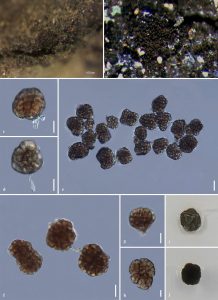Conlarium thailandense X.D. Yu, H. Zhang & K.D. Hyde, sp. nov.; Index Fungorum number: IF555288
Etymology: Named after the country where it was collected, Thailand
Holotype: MFLU 17-1711
Saprobic on dead wood in terrestrial habitat. Sexual morph: Undetermined. Asexual morph: Hyphomycetous. Colonies sporodochial, broadly punctiform, gregarious, raised, dark brown to black. Mycelium mostly immersed on natural substratum, comprising branched, pale brown to hyaline, smooth and thin-walled hyphae. Conidiophores absent or reduced to conidiogenous cells. Conidiogenous cells monoblastic, holoblastic, integrated, determinate, cylindrical, hyaline, smooth, up to 5.5 μm long. Conidia 25–45 × 17–33 μm (x̅ = 35.9 × 26.9 μm, n = 20), acrogenous, solitary, dry, mostly irregular, subglobose to ellipsoidal, brown to dark brown, clathrate, muriform, 4–8-transversely septate, 4–6-longitudinally septate, slightly constricted at the septa, smooth and thin-walled, with a small, sub-rounded, dark brown ornamentation on the surface of each cell. Conidial secession schizolytic.
Culture characteristics: Colonies on PDA, irregular in shape, reaching 10–20 mm in 6 weeks at room temperature,
black from above and below, umbonate, rough, dense, edge undulate.
Material examined: THAILAND, Chiang Rai Province, Mae Fah Luang University, on dead wood, 17 July 2017, S. Boonmee, DP6 (MFLU 17-1711, holotype), ex-type living culture, MFLUCC 17-2349. GenBank numbers: ITS = MH624129, LSU = MH624127, SSU = MH624128.
Notes: Conlarium thailandense is similar to the asexual morph of C. duplumascosporum and C. aquaticum. They all have monoblastic, holoblastic conidiogenous cells and mostly irregular, brown, clathrate, muriform conidia (Liu et al. 2012a). However, they can be easily distinguished by the number of septa (0–2-transversely septate, 0–1-longitudinally septate in C. duplumascosporum, 6–12-transversely septate, 4–10-longitudinally septate in C. aquaticum and 4–8-transversely septate, 4–6-longitudinally septate in C. thailandense) and conidial size (15.5–35 × 11–26.5 μm in C. duplumascosporum, 45–70 × 20–57 μm in C. aquaticum and 25–45 × 17–33 μm in C. thailandense) (Liu et al. 2012a; Zhang et al. 2017a). Apart from number of septa and conidial size, a number of air-bubbles were also observed on mature conidia of C. thailandense, which have not been reported in C. aquaticum and C. duplumascosporum. Phylogenetic analyses of a combined LSU, SSU and ITS sequence alignment based on maximum likelihood and Bayesian inference show that C. thailandense is sister to C. aquaticum. A comparison of ITS pairwise indicates that C. thailandense differs from C. aquaticum in 13 base positions and is therefore novel following the guidelines of Jeewon and Hyde (2016).
Fig. Conlarium thailandense (MFLU 17-1711, holotype). a, b Colonies on the substratum. c, d Conidiogenous cells. e, f Conidia. g Conidia with the air-bubbles. h Fragile conidium. i Colonies on PDA (from front). j Colonies on PDA (from reverse). Scale bars a = 100 μm, c, d, f–h = 10 μm, e = 20 μm.

